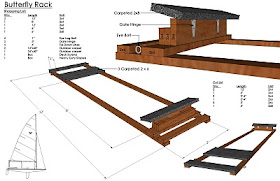SAILING COURSE VS. COMPETITION EXAMPLE
at 7.24.2011
By Doug
Pam and I christened our brand new Butterfly and decided to sail two-up. The weather at White Rock was the usual – winds of 5-15 with lots of shifts. Fantastic July conditions. With the extra weight, we were a little slow but at the end of the second windward-leeward, had a 10-second lead from working the shifts on the first two beats. Here’s what it looked like one minute into the final beat:
Sandy (in red) was pointing higher than us (in green) because the wind was under 10 and we had to foot to keep our centerboard from stalling (Pam and I were more competitive in the gusts). Our narrow lead was definitely at risk, and we figured that Sandy would pull even within a minute. Only one shift would work in our favor, and we got it:
A 20 degree header put Sandy directly behind us. Sailing the course means tacking on headers, and Pam’s first reaction was “Let’s tack.” I said, “No, let’s keep going.” There were two reasons for this. The first is that when a boat is inside, as Sandy was, a lift helps him while a header helps us – simple geometry. With Sandy now behind us, passing would be more difficult, plus he would be more and more in our dirty air as he got closer.
The second reason is that when playing catch-up, the boat behind wants to get separation to get clean air and, more importantly, a chance to play different shifts. The boat in front wants to prevent this by covering the boat that is behind. Had we tacked away from Sandy on the knock, we would have “let go” of him and he could have passed us later in the leg by getting different shifts. The more the separation, the better the chance of getting different shifts:
So instead of doing this, we kept going until Sandy tacked to cover Frank behind him and then we also tacked to cover both. This is an example of sailing the competition and not sailing the course.
But there are exceptions, and Sandy had good options too. He knew that all things being equal, he was faster than Pam and me because we were heavier. He could have continued on port and would have reeled us in with his better boatspeed. This is another case of sailing the competition – the faster boat behind covers and it is now the slower boat in front that wants separation (in this case, we would not been too worried because there was more wind approaching which would have reduced our weight disadvantage).
So, we covered Sandy and Frank by tacking onto starboard. And who won the race? Approaching the finish line, Frank (in yellow) split tacks and went right. He got the separation he needed to get his own last minute shift:
This was rolling the dice, but with the race ending, it was the right move. And it worked! A righty in the last minute helped Frank come in on a lift while we came in on a header with Sandy. Frank won by 5 seconds:
Frank needed the separation and Pam and I had to make the choice about who to cover. And we guessed wrong. Frank sailed the competition and won – nice going!
An interesting footnote: Frank crossed in front of us and chose to head for the pin and we chose the boat end which was more favored. Because our end was favored, the winning margin was closer than it should have been. Another shift to the right on the finish line could have put us in front. Frank should have tacked to cover us – yet another reason to sail the competition, even at the very end of the race.
To satisfy Pam’s need for some simple rules of thumb for when to cover and when to separate we had some perfect examples. Coming up the last windward leg, Pam and I were in front and slower than our competition, Sandy was behind us and faster than us but about equal speed with Frank who was behind him and then Bruce was sneaking up into the mix as well. We, being slow with fast boats behind, needed separation and a chance to catch some shifts because if we stayed where we were, we’d get reeled in. Sandy, with a slow boat in front and a fast boat behind, could reel us in but needed to cover Frank who was behind. Frank needed separation. Bruce, coming from behind Frank had a bird’s eye view of the angles and what to do and not do and followed Frank, caught the last shift, moved into 3rd and passed Sandy and almost caught us.
And, oh by the way, if the racing is close at the finish, always protect the right because it’s worth up to two boat lengths because you have right of way at the finish line.












5/03/2012 4:08 PM
So, in this scenario, you chose NOT to "cross 'em when you can" (to quote Stuart Walker). Would you have approached this situation differently if you were as fast as the other boats? Also, does this approach take into consideration which side of the course you are on - left versus right?
5/04/2012 10:37 AM
Good questions.
Stuart Walker's quotation is for fleet sailing where you want to protect against a group of boats, and it's correct to "put it in the bank" whenever you can.
However, I'm usually sailing against 1 or 2 competitors and ignore the fleet. So I would not have changed my tactics even if I have speed because the red boat is making mistakes. I'd use their local knowledge and my boat speed.
Left vs. right - there are a lot of people who know this lake better than me, so I tend to let them decide and then go with them.
5/05/2012 9:22 AM
OK, so you are basically just keeping a tight cover on the red boat. By left or right, I mean in terms of your proximity to the left or right layline. In your scenario, you stayed to the right (or outside) of the red boat. If you were both on starboard and nearing the port layline, would you have tacked before the red boat (leading him back) and staying to the right (or inside) of him? Again - great blog!
5/06/2012 9:55 AM
But not too tight or else red will break away and I'll have to choose who to cover. I prefer to not interfere so I can learn. In the post I'm writing now (sailing the competition) I disclose my previous vision issues and why my sailing DNA has always been staying close to others.
Laylines - in this scenario where red wants to keep going, I'll be the first to tack just below the starboard tack layline. An experienced skipper (the ones that are the most threat) will keep going to get separation which is forcing them into a low-percentage move. If we get a lift on the layline, he has overstood, and if we get a knock, I've gained and am further ahead.
5/27/2012 12:05 AM
I got this web site from my buddy who informed me concerning this web page and now this time I am visiting
this website and reading very informative articles at this time.
My website - West Marine Coupons